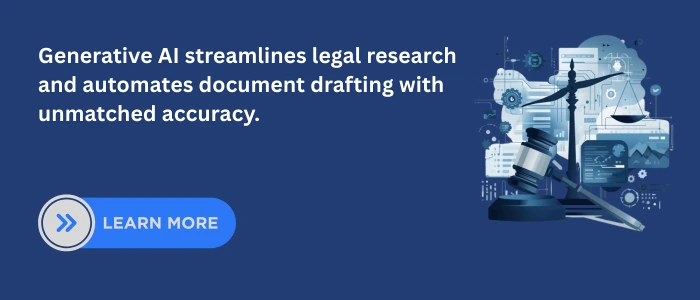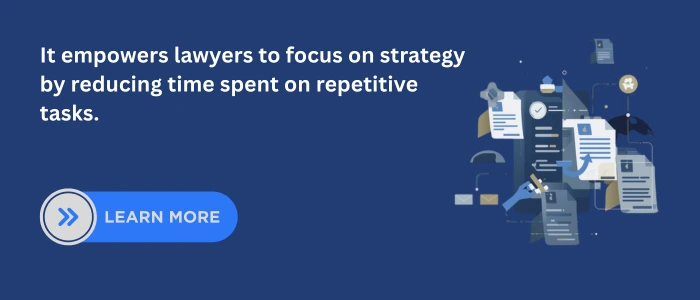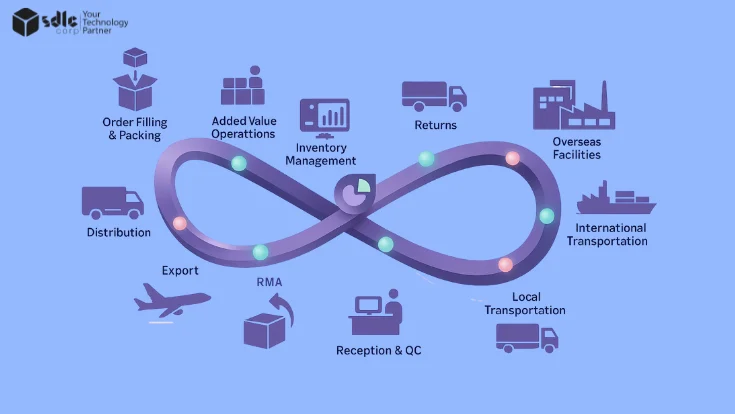Introduction
The legal industry is one of the most document-intensive professions, with lawyers spending hours on contracts, research, compliance, and litigation. While traditional methods ensured accuracy, they often led to inefficiencies, high costs, and barriers for smaller firms. Early tools like LexisNexis and Westlaw improved research but remained rule-based. The rise of Generative AI, powered by LLMs and NLP, marks a major shift—enabling the creation of usable legal content such as contract drafts, case summaries, and predictive insights.
As clients demand faster services and regulations grow more complex, adoption is accelerating worldwide. Countries like the U.S., U.K., Singapore, and India are investing heavily, while the EU leads with the AI Act. Together, these changes point to a future where generative AI becomes indispensable in law. Explore the possibilities with our Custom AI Solutions.
1. Understanding Generative AI in Legal Context
Generative AI refers to advanced systems designed to create new text, images, or structured data by learning patterns from massive datasets. Unlike earlier legal technologies that could only retrieve or sort through information, generative AI can actually produce usable content. In the legal domain, this means generating contracts, legal briefs, compliance reports, case summaries, and even client advisories from large bodies of existing legal knowledge.
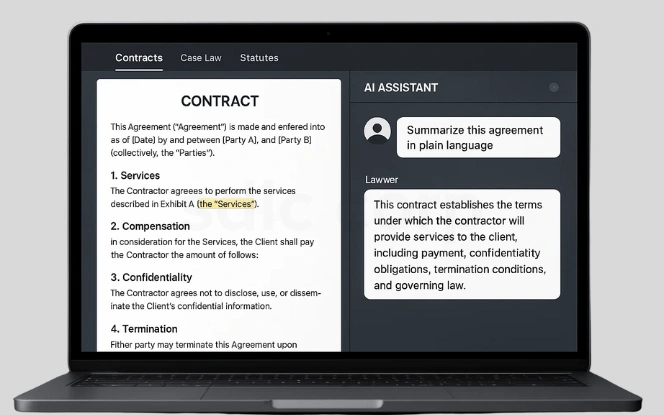
Key Components of Generative AI in Law
- Large Language Models (LLMs):
These are trained on billions of legal and non-legal documents, including statutes, regulations, and judicial opinions. By analyzing these data points, LLMs can draft contracts, summarize judgments, and even suggest precedent-based arguments with remarkable speed. - Natural Language Processing (NLP):
NLP enables AI to parse and interpret complex legal language, translating it into plain English or structured summaries. For example, instead of manually reading a 200-page judgment, lawyers can request an AI-generated brief highlighting the most relevant holdings, statutes cited, and judicial reasoning. - Machine Learning (ML):
Machine learning algorithms continuously refine AI outputs by identifying patterns across thousands of judgments, contracts, or filings. Over time, ML improves accuracy, reduces errors, and adapts to new regulations or case law developments.
Why Generative AI Is Transformative
Unlike traditional rule-based legal software, which relies on pre-coded instructions and Boolean searches, generative AI:
- Produces original, structured outputs rather than just retrieving documents.
- Understands context, enabling it to draft memos, contracts, or compliance updates aligned with a firm’s needs.
- Responds to natural-language queries, allowing lawyers to ask questions in plain English such as “What precedents support wrongful termination claims under California law?”
Learns and adapts over time, making it increasingly accurate and context-aware with each use.
Practical Example
Consider the difference between an e-discovery tool and generative AI:
- An e-discovery system might retrieve 500 documents containing the keyword “confidentiality clause.”
- A generative AI tool, however, could summarize those documents, highlight the risky or unusual clauses, and even draft a recommendation memo for negotiation strategy.
This ability to not only find but also create actionable legal content marks the true value of generative AI in legal practice.
2. Applications of Generative AI in the Legal Industry
Contract Analysis and Drafting
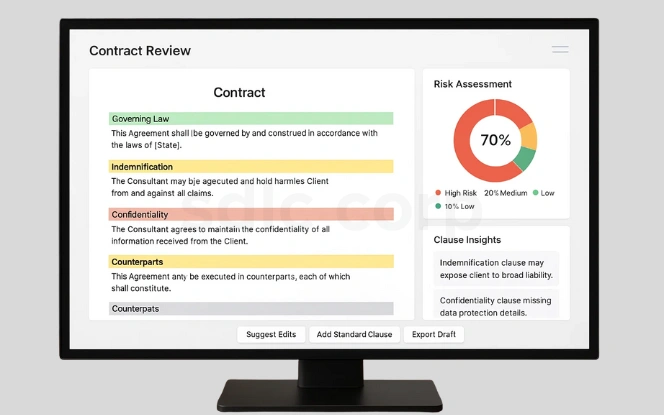
Contract review is one of the most labor-intensive tasks in law. Generative AI can review thousands of contracts within minutes, flagging risky clauses such as indemnification or confidentiality, identifying compliance gaps, and highlighting missing provisions. Beyond review, AI assists in drafting by generating first versions of contracts pulled from clause libraries or precedent databases.
Business Impact: Lawyers spend less time on repetitive reviews and more on negotiation and strategic advisory.
Legal Research
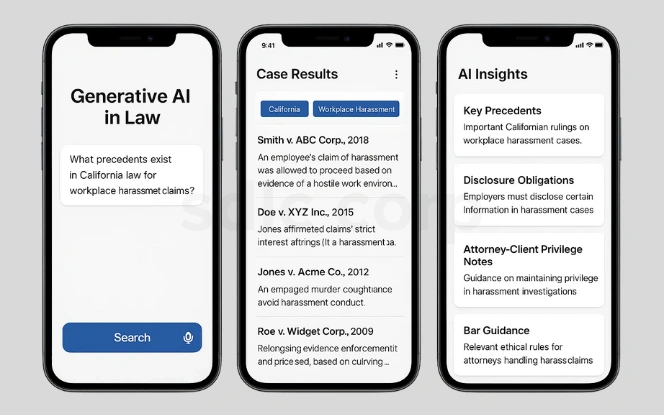
Traditional legal research often requires hours of combing through case law with Boolean searches. Generative AI allows lawyers to pose natural-language questions like:
“What precedents exist in California law for workplace harassment claims?”
Tools such as Harvey AI and Lexis+ AI then return case summaries, citations, and structured arguments.
Business Impact: Research time is reduced dramatically, and risks of missing precedents are minimized.
Due Diligence in Mergers and Acquisitions
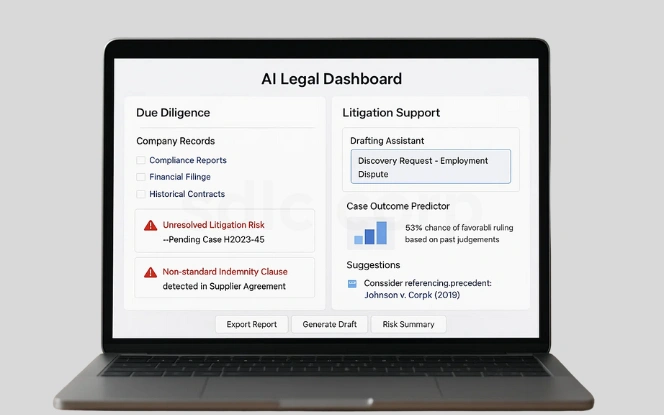
Corporate transactions require reviewing compliance records, contracts, and company filings. Generative AI automates this process by highlighting anomalies such as pending litigation or unusual indemnity clauses.
Business Impact: Due diligence is completed faster, more accurately, and at lower cost.
Litigation Support and Case Preparation
Litigation teams often spend weeks drafting pleadings, preparing discovery requests, and developing strategies. Generative AI assists by drafting initial documents, suggesting strategies based on similar cases, and predicting outcomes.
Example: An AI system could estimate the likelihood of success in an employment discrimination lawsuit by analyzing precedent across multiple jurisdictions.
Check Out : How Blockchain Developers Ensure Compliance with Industry Standards?
Compliance and Regulatory Monitoring
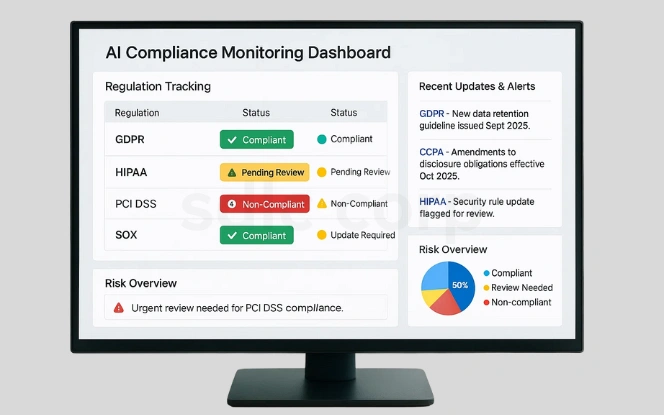
Regulatory frameworks evolve constantly. AI-powered dashboards now track GDPR, HIPAA, CCPA, PCI DSS, and SOX in real time. Compliance officers can monitor updates and receive alerts about new rules, reducing the risk of oversight.
Business Impact: Multinational firms can ensure compliance across jurisdictions without overburdening legal teams.
Client Interaction and Legal Chatbots
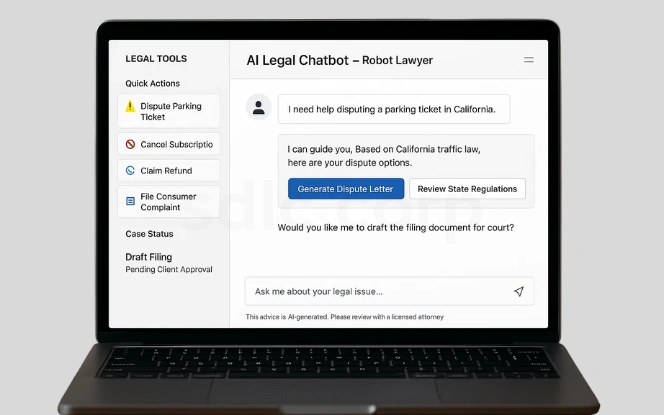
Generative AI powers client-facing tools such as chatbots. These handle FAQs, intake forms, and even basic advice.
Example: DoNotPay, often called the “robot lawyer,” helps consumers fight parking tickets, cancel subscriptions, and claim refunds.
Business Impact: Expands access to justice by reducing costs and improving efficiency.
3. Benefits of Generative AI in Law
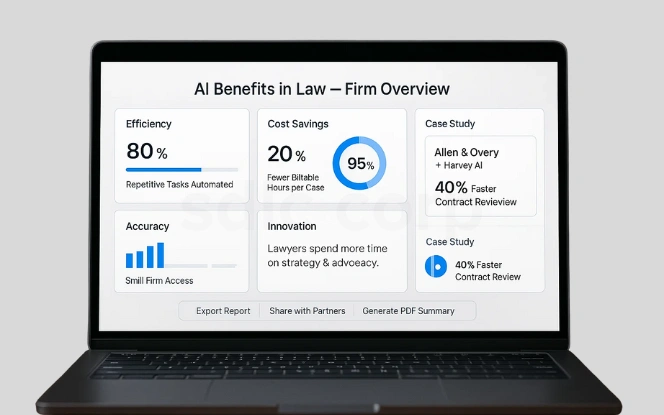
The adoption of generative AI provides multiple benefits for both law firms and clients, helping the legal industry become more efficient, accurate, and accessible.
- Efficiency: Automates repetitive tasks such as contract review, research, and compliance tracking, allowing lawyers to focus on higher-value work.
- Cost Savings: Reduces the number of billable hours spent on routine processes, making legal services more affordable for clients while improving firm profitability.
- Accuracy: Minimizes human errors in large document reviews by consistently detecting risky clauses, compliance gaps, or anomalies.
- Scalability: Enables small and mid-sized firms to compete with larger players by giving them access to advanced legal research and drafting tools.
- Innovation: Frees up lawyers to focus on advocacy, strategy, and client relationships while AI handles groundwork and data-heavy tasks.
Case Example: Allen & Overy partnered with Harvey AI for contract review, allowing lawyers to save significant time without compromising quality. This demonstrated how AI can act as a supportive co-pilot, enhancing productivity while ensuring professional oversight.
Read Also : Odoo ERP for Legal Firms: Managing Cases and Clients Easily
4. Technical Challenges and Risks
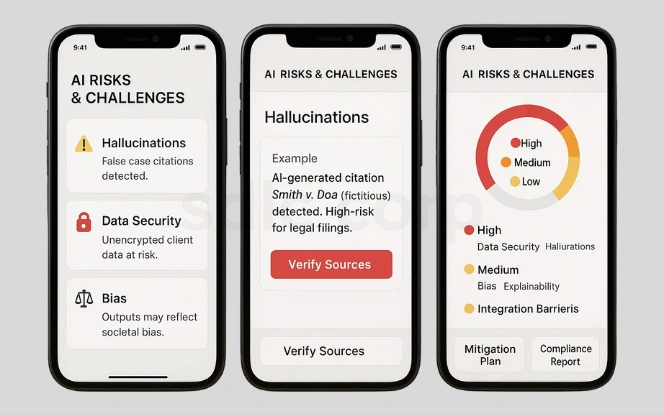
Despite its promise, generative AI in law also presents important challenges and risks that firms must address before large-scale adoption:
- Hallucinations: AI systems can sometimes generate false citations, misinterpret legal precedent, or provide fabricated references. This risk highlights the importance of human oversight in all AI-assisted work.
- Data Security: Legal practice involves highly sensitive client information. If AI tools are not properly encrypted or if data is processed on unsecured platforms, it may expose confidential material to breaches or misuse.
- Bias in AI Models: Since AI models learn from historical data, they may unintentionally reproduce societal, cultural, or judicial biases, leading to unfair or skewed outcomes.
- Lack of Explainability: AI may deliver correct answers but without clear reasoning or transparency into how the result was generated. This “black box” problem is especially concerning in legal contexts where justification is critical.
- Integration Barriers: High implementation costs, infrastructure requirements, and cultural resistance within traditional law firms make it difficult to adopt AI smoothly, especially for smaller practices.
Addressing these risks requires responsible AI frameworks, strict data governance, and continuous human oversight to ensure accuracy, fairness, and ethical use in legal practice.
Explore More : Legal Aspects of Online Gaming in India
5. Ethical and Regulatory Considerations
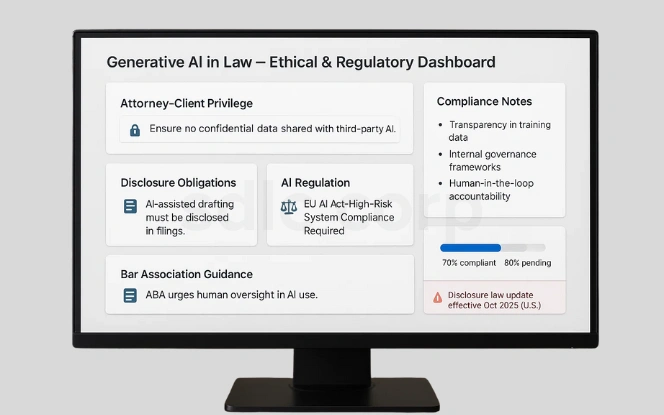
Generative AI in law is closely tied to issues of ethics, trust, and regulatory compliance. Since legal work directly affects people’s rights and responsibilities, maintaining integrity and accountability is essential.
Key Issues:
- Attorney-Client Privilege: AI tools must be implemented in ways that protect confidentiality. Using unsecured or third-party platforms without proper safeguards could expose sensitive client data.
- Disclosure Obligations: Some courts and jurisdictions now require lawyers to disclose when AI has been used in drafting or reviewing documents. Transparency helps maintain fairness and trust in the legal process.
- AI Regulation:
- The EU AI Act categorizes legal AI applications as high-risk, demanding stricter compliance and oversight.
- In the U.S., proposals such as mandatory disclosure of training data are being discussed to ensure accountability.
- The EU AI Act categorizes legal AI applications as high-risk, demanding stricter compliance and oversight.
- Bar Association Guidance: Professional bodies, including the American Bar Association and others, emphasize that AI should support—not replace—lawyers, with human oversight remaining essential.
Best Practice: Law firms should establish internal governance frameworks that focus on transparency, accountability, and bias mitigation. This includes clear policies on how AI tools are used, continuous monitoring of outputs, and documented processes to demonstrate compliance with ethical standards.
6. Future of Generative AI in Legal Work
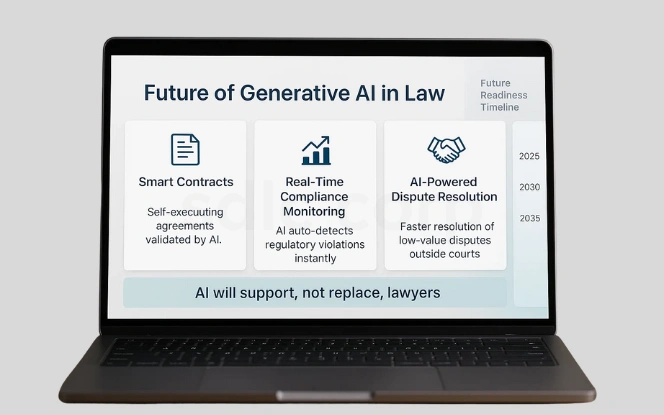
The future of generative AI in law lies in collaboration rather than replacement. AI will continue to act as a co-pilot, handling repetitive and data-intensive work, while lawyers focus on higher-value skills such as judgment, advocacy, and negotiation.
Emerging Developments:
- Smart Contracts: AI-enabled agreements that can be automatically validated, monitored, and enforced, reducing the need for manual oversight in routine transactions.
- Real-Time Compliance Monitoring: AI systems capable of continuously scanning regulatory updates across jurisdictions, immediately flagging risks or violations to legal teams.
- AI-Powered Dispute Resolution: Tools designed to resolve low-value or high-volume disputes quickly, helping courts and firms reduce backlog while offering clients faster settlements.
In this future landscape, lawyers remain central to decision-making and client trust, but their roles evolve to focus more on strategic, human-driven work, supported by AI-driven efficiency.
Read More : AI for The Legal Industry: Transforming Law Firms with AI
7. Best Practices for Implementation
Law firms considering generative AI adoption should follow a structured approach to maximize benefits while minimizing risks.
- Start Small: Begin with pilot projects in areas such as legal research or contract review. These quick wins help build confidence and demonstrate ROI.
- Secure Data: Always prioritize encrypted systems, private LLMs, or on-premise solutions to safeguard sensitive client information.
- Maintain Oversight: Human review of AI-generated outputs is essential to ensure accuracy, fairness, and compliance.
- Train Staff: Provide ongoing training so lawyers and support teams can use AI responsibly and effectively.
- Vet Vendors: Partner only with providers that have a strong track record of compliance, security, and reliability.
Executive Checklist:
- Define 3–5 measurable AI goals aligned with firm strategy.
- Conduct regular data security and governance audits.
- Launch pilot projects in at least one practice area.
- Train staff on responsible AI adoption and usage.
- Establish governance and ethics guidelines to ensure accountability.
By following these best practices, law firms can adopt generative AI responsibly, unlocking efficiency and innovation while protecting professional standards.
Conclusion
Generative AI is reshaping the legal industry. From research and drafting to compliance and client interaction, it enables lawyers to work smarter, faster, and more effectively. While risks such as hallucinations, bias, and ethical concerns exist, firms that adopt responsible frameworks will gain a competitive advantage. The future of law is not AI versus lawyers, but AI with lawyers. Firms that embrace responsible adoption will improve efficiency, deliver superior client service, and remain competitive in an increasingly digital world.
Ready to explore how AI can transform your legal practice? Discover tailored solutions with our AI Development Solution.
FAQs
Is it safe to rely on AI citations in court?
No. AI hallucinations remain a risk. Always verify citations against trusted legal databases.
Should lawyers disclose AI use?
Yes. Courts in some jurisdictions now mandate disclosure of AI involvement in drafting or arguments.
How common is AI in legal practice?
Recent reports show that 63%–85% of lawyers use generative AI tools weekly.
What are the biggest risks?
Hallucinations, bias, data security, and ethical liability.
Can AI replace lawyers?
No. AI lacks judgment and accountability. It serves best as a support tool.

